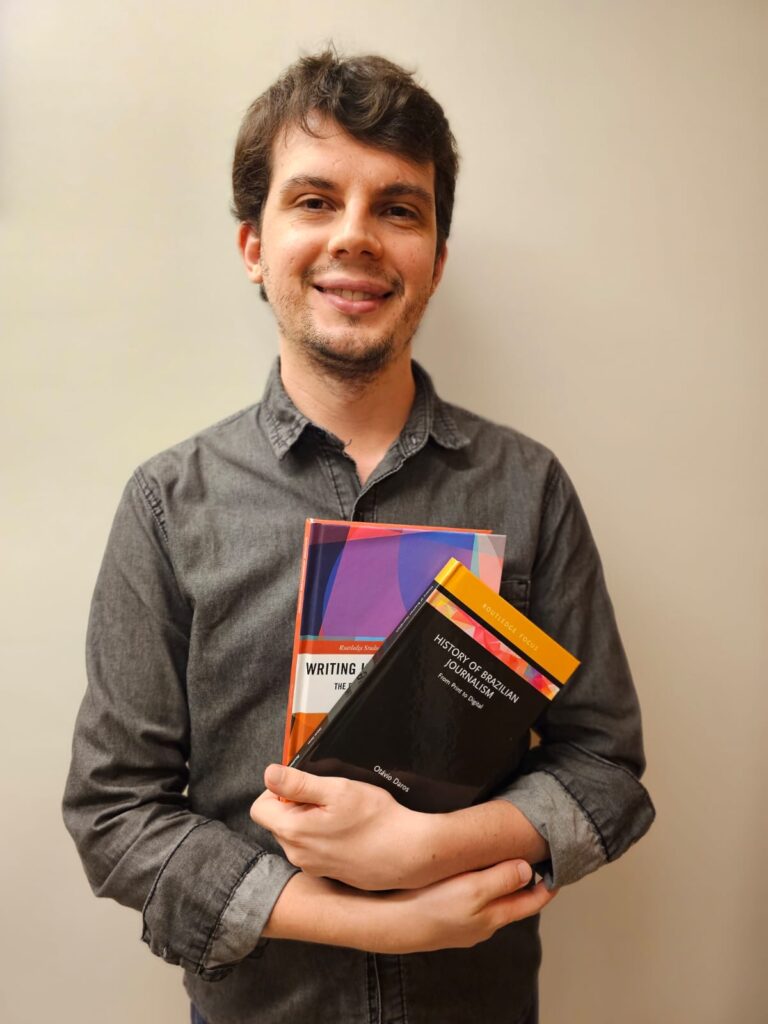It’s rare for a Brazilian author to release two books in English through international publishers – almost at the same time. But that’s exactly what Otávio Daros did. He is currently a postdoctoral researcher in communication at the Catholic University of Rio Grande do Sul.
The first book, Writing Journalism History, was published in the second half of 2024 and is based on his doctoral dissertation, which he began in 2019. It explores the academic field of journalism studies in Brazil—specifically, how Brazilian journalism history has been told by scholars.
His second book, History of Brazilian Journalism, released in December, presents his own version of the country’s journalism history in a concise, introductory format for those interested in the subject.
To learn more about these works, LatAm Journalism Review (LJR) spoke with Daros over video call about the history of journalism in Brazil and elements in the history that he thinks have been overlooked.
The interview has been edited for clarity and conciseness.

Author Otávio Daros smiles while holding his two recently published books: "History of Brazilian Journalism" and "Writing Journalism History" (Photo: Daniel Grings Cedeño)
LJR: How does your own history of Brazilian journalism compare to existing ones?
Otávio Daros: One of the main differences is that my book is not a traditional history of the press. I examine journalism as a practice that emerged in print media but evolved in radio, television, and, over the past three decades, the internet.
My approach focuses on how this practice changes over time—what characteristics it loses and gains—rather than limiting the narrative to printed newspapers. Most journalism history books were written before 2000, and many treat press history as solely the history of print media.
LJR: At what point do you think Brazilian journalism stood out as a democratic force? And when did it move away from that ideal?
Daros: Journalism has played a crucial role at various moments in Brazil’s history. During the abolition of slavery, for instance, the press amplified the voices of Black journalists.
In the 20th century, I’d highlight the period of redemocratization. Journalism became an important channel for demands that had previously been suppressed.
It’s paradoxical how mainstream journalism both supported and legitimized the conditions that led to the 1964 military coup and, two decades later, became a catalyst for new social demands.
During Bolsonaro’s government, we saw the rise of even more conservative media outlets. At the same time, during the COVID-19 coverage, the press played a key role in countering denialism.
LJR: What does the history of journalism historiography reveal about the concerns of different eras? Where do we stand now?
Daros: My dissertation aimed to analyze different historical narratives about journalism. Early journalism historians during Brazil’s imperial period sought to elevate the journalism of their time because they were part of a broader national identity-building effort.
A century later, historians began questioning and deconstructing these narratives. During and after the military dictatorship, we see a much more critical perspective.
From a historiographical standpoint, official histories declined, making way for a cultural history approach that focuses on symbolic and imaginative aspects. Early histories centered on prominent journalists, whereas today, we see accounts of the first women journalists and discussions on the profession’s structural issues.
LJR: In one of your books, you argue that journalism in Brazil has become subordinate to the broader field of communication studies. What do you mean by that?
Daros: Journalism studies have been absorbed into the academic field of communication. This sometimes creates the false impression that communication as a whole is more complex than journalism itself.
It’s a mistake to think that journalism history has been replaced by a new history of communication. Journalism historiography still faces major challenges and has many unexplored topics.
LJR: What overlooked topics deserve more research?
Daros: For example, the history of LGBTQ+ journalism in Brazil, the contributions of Black journalists, and the role of women in different historical periods.
Journalism history seeks to understand how present-day issues originated. Take today’s discussions on newsroom diversity—when did those debates first emerge in history?
LJR: An interesting fact is that Brazil has the highest percentage of journalists with a degree in journalism—over 90% of professionals have a degree in the field. Does that impact professional practice?
Daros: The journalism degree requirement played a key role in shaping journalism’s identity in Brazil.
Here, the diploma mandate coincided with a period of economic development and industrialization. That combination helped professionalize Brazilian journalism.
LJR: Are there too many communication schools in Brazil? How do you explain the crisis in the field?
Daros: Over the past 15 years, the economic crisis in many media companies has worsened, partly due to Brazil’s deindustrialization. That has affected universities, leading to declining interest in journalism programs.
When I started college in 2013, journalism courses were among the most sought-after. Today, journalism is no longer seen as an attractive career.
On one hand, we’ve witnessed a democratization of higher education. On the other, unregulated growth that doesn’t match job market conditions has created problems for both professionals and academics.
LJR: Where do you think journalism is headed now?
Daros: We’re seeing a decline in journalism as we knew it in past decades. The challenge now is finding ways to sustain journalism while maintaining quality, especially in an era of growing hostility toward the press.
Many aspects of traditional newsrooms are changing. Media companies are rethinking how they engage with advertising while facing new obstacles in news production.
The core question remains the same: how can we have independent, high-quality journalism in a landscape that has different challenges from those we saw 50 years ago.